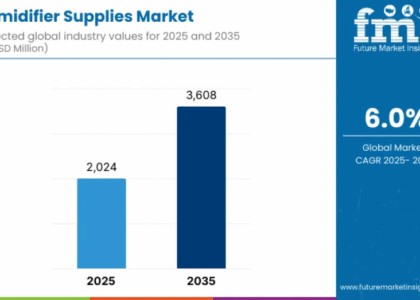The global Calprotectin Testing Market is estimated to be valued at USD 51,143.1 million in 2025 and is projected to reach USD 92,457.3 million by 2035, registering a compound annual growth rate (CAGR) of 6.1% over the forecast period. The market is driven by rising prevalence of inflammatory bowel diseases (IBD), growing awareness of early non-invasive diagnostics, and efforts to reduce colonoscopy reliance.
The calprotectin testing market has gained significant attention in recent years, owing to the rising awareness of gastrointestinal diseases and the importance of non-invasive diagnostic methods. Calprotectin is a protein found in neutrophils, and its presence in stool samples is a reliable biomarker for inflammation in the intestines. This makes calprotectin testing a valuable tool in diagnosing and monitoring conditions such as inflammatory bowel disease (IBD), Crohn’s disease, and ulcerative colitis. As healthcare systems increasingly shift toward early diagnosis and precision medicine, the demand for efficient and accurate testing methods is growing. The calprotectin testing market is expanding to meet this demand, supported by advancements in laboratory technologies and increasing public health initiatives.
Get Sample Report: – https://www.futuremarketinsights.com/reports/sample/rep-gb-14504
Clinicians prefer calprotectin testing because it helps distinguish between inflammatory and non-inflammatory gastrointestinal disorders, reducing the need for invasive procedures like colonoscopies. Additionally, the market benefits from the growing preference for home-based diagnostic kits, which offer patients a convenient and private way to monitor their conditions. As healthcare providers emphasize patient-centric approaches, calprotectin testing plays a key role in enabling personalized treatment strategies.
Market Trends
The calprotectin testing market is undergoing rapid evolution, driven by both technological advancements and shifting healthcare priorities. One prominent trend is the increasing integration of automated systems and point-of-care testing. Laboratories and clinics are adopting fully automated platforms that improve the speed and accuracy of calprotectin results. These systems help reduce the turnaround time for test results, enabling quicker clinical decisions and better patient outcomes.
Another notable trend is the surge in demand for home-based diagnostic solutions. As patients seek more autonomy in managing chronic conditions, manufacturers are developing user-friendly calprotectin test kits for at-home use. These kits are particularly useful for ongoing disease monitoring, allowing patients to track flare-ups or treatment responses without frequent clinic visits. In tandem with this, the use of digital health platforms is rising. Many companies now offer mobile apps that sync with test kits, providing users with real-time data and remote consultations with healthcare providers.
Additionally, the calprotectin testing market is benefiting from increasing research and development activities. Pharmaceutical and biotechnology companies are investing in diagnostic innovations that utilize calprotectin as a marker for broader applications beyond gastrointestinal health. This includes potential roles in oncology, rheumatology, and infectious diseases. Such diversification opens new revenue streams and broadens the market’s clinical relevance.
Challenges and Opportunities
Despite its growth, the calprotectin testing market faces several challenges. One major hurdle is the lack of awareness among patients and even healthcare providers in some regions. Many individuals experiencing gastrointestinal symptoms may not be aware that non-invasive options like calprotectin testing exist. Education and awareness campaigns are essential to drive wider adoption and increase test volumes.
Another challenge lies in the variability of test results due to differences in laboratory standards and methodologies. Without standardized testing protocols, clinicians may face difficulties in interpreting results, potentially leading to inconsistent diagnoses. Regulatory bodies and professional organizations must work together to establish universal testing guidelines to ensure reliability and trust in the results.
However, these challenges also present opportunities. As awareness of gastrointestinal disorders continues to grow, there is potential for market players to launch educational initiatives and public outreach programs. These efforts can boost test adoption rates and expand market penetration. Furthermore, the growing emphasis on preventive healthcare and early disease detection supports increased demand for reliable diagnostic tools. Governments and insurance providers are likely to include calprotectin testing in standard screening programs, especially for populations at risk for IBD and other inflammatory conditions.
Key Regional Insights
The calprotectin testing market exhibits diverse regional dynamics based on healthcare infrastructure, disease prevalence, and public health policies. In North America, the market is thriving due to a high prevalence of IBD, robust healthcare facilities, and well-established diagnostic networks. The United States leads the region with advanced laboratory services and widespread awareness of gastrointestinal health. Insurance reimbursement for calprotectin testing also encourages its routine use among healthcare providers.
Europe is another key region where the calprotectin testing market is growing steadily. Countries like Germany, the UK, and France have been early adopters of stool-based diagnostic tools. The presence of universal healthcare systems and proactive patient screening programs further fuels the market’s growth in the region. European research institutions are also actively involved in calprotectin-related studies, supporting innovation and clinical validation.
In contrast, the Asia-Pacific region presents immense growth potential, though it currently faces limitations such as lower awareness and limited access to advanced diagnostic tools. However, as healthcare investment surges in countries like China, India, and Japan, the market outlook is becoming more favorable. With rising disposable incomes and expanding healthcare access, the demand for non-invasive diagnostic methods is expected to rise.
Other regions, including Latin America and the Middle East & Africa, are beginning to recognize the value of calprotectin testing. Government health initiatives aimed at improving gastrointestinal care and early disease detection are likely to foster future growth, although challenges like infrastructure limitations and cost barriers remain.
Competitive Outlook
The competitive landscape of the calprotectin testing market is marked by intense innovation and strategic collaborations. Companies are investing in research and development to improve test sensitivity, reduce turnaround times, and expand clinical applications. As the demand for at-home diagnostics increases, players are also entering partnerships with digital health startups to deliver integrated testing solutions.
Market competition is driving advancements in both product design and manufacturing. New entrants are introducing compact and easy-to-use testing kits, appealing to a broader consumer base. Meanwhile, established players are focusing on expanding their global footprint by entering emerging markets and localizing production to reduce costs.
In addition, mergers and acquisitions are common in the calprotectin testing market. Diagnostic firms are acquiring smaller players with niche technologies to strengthen their product offerings and accelerate market penetration. This consolidation trend contributes to the rapid development of comprehensive and efficient testing platforms.
Top Companies
Several major companies play a pivotal role in shaping the calprotectin testing market. These include prominent diagnostic manufacturers and biotechnology firms that have developed a range of products targeting both clinical and consumer segments. These companies leverage strong distribution networks, extensive research capabilities, and brand recognition to maintain their competitive edge.
Their portfolios often include laboratory-based tests, point-of-care systems, and home-testing kits. Leading firms continuously invest in clinical validation and regulatory approvals to ensure product quality and trust among healthcare providers. Furthermore, these companies are exploring advanced technologies such as artificial intelligence and machine learning to enhance diagnostic accuracy and predictive capabilities.
Some of the top players are also expanding into complementary areas such as inflammatory biomarker panels, enabling clinicians to obtain a broader view of a patient’s condition. This holistic approach to diagnostics not only strengthens their product lines but also adds value to healthcare systems focused on precision medicine.
Segmentation Outlook
The calprotectin testing market can be segmented based on product type, test type, end-user, and application. By product type, the market includes ELISA kits, lateral flow assays, and others. ELISA kits dominate the market due to their high sensitivity and wide usage in clinical laboratories. However, lateral flow assays are gaining traction, particularly for point-of-care and home-based applications.
In terms of test type, quantitative and qualitative tests form the primary segments. Quantitative tests are more prevalent in clinical settings as they provide detailed information on inflammation levels, guiding treatment plans effectively. Qualitative tests are popular for rapid screening and are often used in home-testing kits.
Based on end-users, hospitals, diagnostic laboratories, and home care settings are the major segments. Diagnostic laboratories represent the largest market share due to the high volume of tests conducted and the availability of advanced testing infrastructure. However, home care is the fastest-growing segment, driven by consumer demand for convenience and remote healthcare solutions.
Application-wise, the calprotectin testing market is largely centered around the diagnosis and monitoring of IBD, Crohn’s disease, and ulcerative colitis. As research continues, new applications in other inflammatory and autoimmune conditions are likely to emerge, further diversifying the market landscape.
Explore In-Depth Analysis-Click Here to Access the Report:- https://www.futuremarketinsights.com/reports/calprotectin-testing-market
About Future Market Insights (FMI)
Future Market Insights, Inc. (ESOMAR certified, recipient of the Stevie Award, and a member of the Greater New York Chamber of Commerce) offers profound insights into the driving factors that are boosting demand in the market. FMI stands as the leading global provider of market intelligence, advisory services, consulting, and events for the Packaging, Food and Beverage, Consumer Technology, Healthcare, Industrial, and Chemicals markets. With a vast team of over 400 analysts worldwide, FMI provides global, regional, and local expertise on diverse domains and industry trends across more than 110 countries.
Contact Us:
Future Market Insights Inc.
Christiana Corporate, 200 Continental Drive,
Suite 401, Newark, Delaware – 19713, USA
T: +1-347-918-3531
For Sales Enquiries: sales@futuremarketinsights.com
Website: https://www.futuremarketinsights.com
LinkedIn| Twitter| Blogs | YouTube





